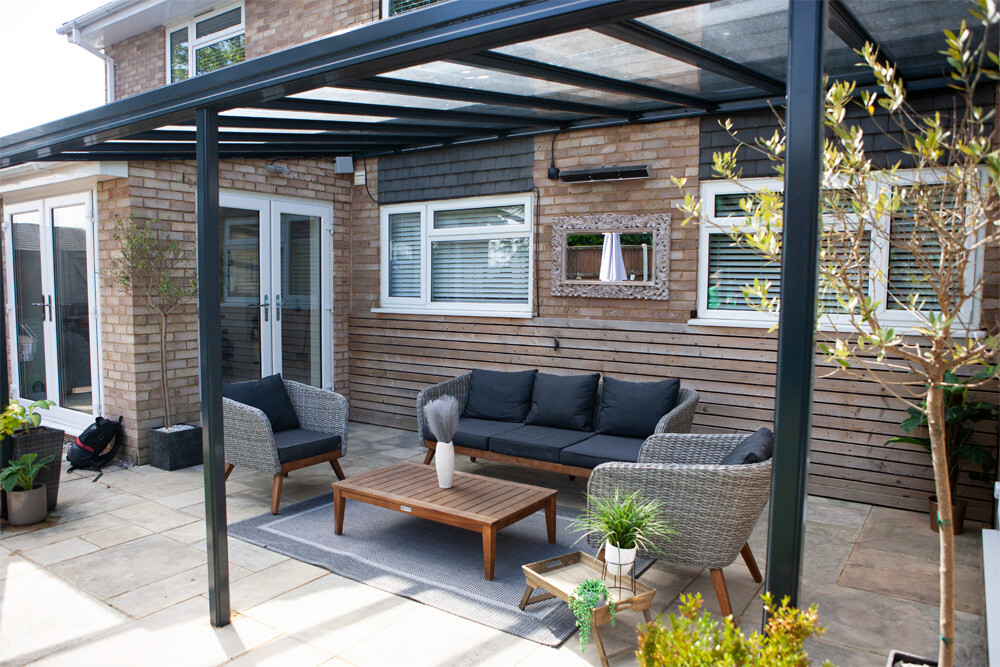Lean-to-roofing is an elegantly simple and aesthetically pleasing solution that transforms your space, be it a cosy addition to your garden, a protective carport, or a sunlit conservatory.
It maximises your living space and adapts gracefully to various architectural styles, from a cottage’s rustic charm to a modern bungalow’s sleek lines.
Its sloping design ensures efficient water run-off and offers an array of materials to suit your taste and budget.
Whether you envision a robust polycarbonate cover that bathes your kitchen in natural light or a slate roof that complements your house’s traditional look, a lean-to roof’s versatility caters to all.
Keep reading to discover how to bring these ideas to life and ensure your extension is as practical as stunning.
What is a Lean-to Roof?
A lean-to-roof, often seen in the construction of carports, garden verandas, and extensions, epitomises simplicity with its single, sloping surface that extends from the main structure. Unlike more complex roof structures, its uncomplicated design makes it ideal for spaces requiring straightforward yet effective coverage.
The essence of a lean-to-roof is rooted in its practical approach: a single pitch, typically angled away from the main house, to ensure water run-off. This attribute enhances its practicality regarding weather protection and contributes to its economic feasibility.
In terms of materials, lean-to-roofs offer flexibility. The lean-to design adapts seamlessly if you prefer traditional roof tiles or modern polycarbonate sheets. Its simplicity in structure does not constrain aesthetic variation:
- For those favouring a rustic appeal, wooden battens and slate tiles can manifest a charming, cottage-like ambience.
- Conversely, metal roofing embodies modernity with its sleek lines and durability, making it suitable for contemporary garden verandas or carports.
- Polycarbonate sheets introduce an element of lightness and transparency, ideal for spaces where natural light is paramount.
The versatility of a lean-to-roof extends beyond material choices. Its adaptability in shape and size allows it to become an integral part of various architectural designs, from extending a kitchen or bathroom to adding a conservatory or a sheltered outdoor space. With the right planning and design, a lean-to-roof can transform an ordinary area into a functional and visually appealing part of your home.
Types of Materials for Lean-to Roofing
Exploring the materials for lean-to-roofing broadens your architectural choices, enabling a harmonious blend with your existing house design. Polycarbonate stands out as a prominent choice, celebrated for its durability and capability to transmit ample natural light, making it ideal for garden verandas thirsting for sunlight. This material’s adaptability marries well with the straightforward structure of a lean-to-roof, ensuring a functional yet aesthetic addition to your outdoor space.
Metal roofing, embracing varieties such as steel, aluminium, and copper, offers a contemporary twist to the traditional lean-to design. Its resilience against extreme weather, coupled with a sleek finish, can significantly elevate the appearance of your carport or extension. The sheen of a metal roof, juxtaposed against the organic textures of your garden or house, creates a visually striking modern and timeless contrast.
Consider employing slate or clay tiles for a deeper connection with traditional architecture. These materials resonate with heritage, effortlessly infusing warmth and character into your project. Furthermore, their natural durability and resistance to harsh weather conditions make them an outstanding selection for lean-to-roofs, especially in areas exposed to the whims of the United Kingdom’s climate.
Bitumen roofing, often chosen for its cost-effectiveness, presents a pragmatic solution without compromising performance. This versatile material adapts smoothly to the lean-to’s single-pitched structure, offering a robust shield against precipitation and heat. It’s particularly suitable for utility spaces such as sheds or workshops, where functionality reigns supreme over aesthetic concerns but still demands a reliable roofing answer.
Ideas for Lean-to-Roofs
Delving into the possibilities for lean-to-roofs, you’re presented with a spectrum of design opportunities that range from the nostalgia of traditional styles to the sleek and innovative appeal of modern configurations.
Whether grounded in the historical charm of classical elements or pushing the boundaries with contemporary materials and layouts, each approach can significantly enhance your structure’s aesthetic and functional value.
Furthermore, the exploration doesn’t end with these mainstream categories; additional lean-to-roof ideas await, offering unique and customisable solutions tailored to meet specific needs and preferences.
This segment is your guide through the nuances of traditional and modern lean-to-roof designs, alongside other inventive concepts that might be the perfect fit for your project.
Traditional Lean-to-Roof
Immersing your space in the timeless beauty of traditional lean-to-roof designs starts with embracing materials that carry historical significance and age-old charm. Consider slate or clay tiles, which mirror the classic aesthetic of English countryside homes and offer remarkable resilience against the UK’s variable weather. Utilising these materials, your lean-to project can embody the past while efficiently serving today’s needs.
When envisioning a traditional lean-to-roof for your garden veranda or carport, the integration of wooden structural elements plays a crucial role. Wood beams’ warmth and natural texture, combined with a meticulously constructed slate or clay-tiled roof, can transform a simple extension into a cosy, inviting outdoor haven. This approach enhances the overall ambience and seamlessly ties the new structure to your home’s architectural heritage.
Modern Lean-to-Roof
Embracing modern lean-to-roof designs opens a portal to innovative aesthetics and functionality that redefine your space. Unique materials like polycarbonate and metal promise longevity and resistance to the elements, allowing for creative freedom. They enable sleek, minimalist lines that harmonise with contemporary architecture.
The allure of modern design lies in its ability to merge efficiency with elegance, and this is where aluminium or steel structures come to the forefront. Their lightweight nature, combined with the potential for incorporating large glass panels, ensures your lean-to extension is not just a shelter but a luminous, integrated part of your house that blurs the boundaries between indoor and outdoor living.
Additional Lean-to-Roof
If you’re exploring lean-to-roofing further, consider embarking on a path less travelled by integrating eco-friendly materials and solar panels. This adds a unique twist to your outdoor space and contributes to energy efficiency, making your lean-to project a testament to sustainable living. The blend of green technology with traditional or modern designs paves the way for a roof that shelters and gives back to the environment.
Another innovative design for lean-to-roofs is incorporating skylights or opening roof systems. These additions invite natural light into your space, transforming it into a bright, airy sanctuary that complements any part of your house, whether a kitchen extension or a cosy garden veranda. It’s a creative way to enhance the architectural interest of your lean-to while maximising the connection with the outdoors, providing you with an inviting retreat regardless of the weather.
Maintenance Tips
Maintaining your lean-to-roof requires regular inspections to ensure its integrity. Bi-annual checks, preferably in spring and autumn, allow you to spot and address potential issues before they escalate. Pay particular attention to the material’s condition, whether polycarbonate, metal, or tile, looking for signs of wear or damage that could compromise your roof’s effectiveness.
Cleaning your lean-to-roof is essential for preserving its aesthetic appeal and functional quality. Debris, like leaves, branches, and dirt, can accumulate over time, potentially obstructing water runoff and leading to moisture-related problems. Safely removing such debris and gently cleaning the roof material itself helps keep your structure looking its best and functioning properly.
For lean-to-roofs incorporating materials such as polycarbonate or glass, it’s crucial to check the seals and flashing periodically. These components are vital for preventing water ingress, but they can become compromised over time. Inspecting them regularly and addressing any issues promptly will safeguard your space against leaks and moisture damage.
Lastly, if your lean-to-roof is part of a larger structure, like a conservatory or extension, it’s important to monitor the overall health of the entire system. This includes checking the alignment and stability of the frame, ensuring doors and windows operate smoothly, and ensuring all seals remain intact. Proactive maintenance extends the life of your lean-to-roof and enhances your space’s security and enjoyment.
Conclusion
In conclusion, your venture into lean-to-roofing conjures a myriad of design and material possibilities tailored to enhance the functionality and aesthetics of your outdoor spaces. From traditional approaches that evoke a rustic charm to modern designs that speak of elegance and efficiency, your choice sets the stage for a transformation that resonates with your style and your home’s architectural symphony.
Remember, the journey of selecting suitable materials – be it the robustness of metal or the clarity of polycarbonate sheets – plays a pivotal role in your lean-to roof’s long-term satisfaction and durability. Each selection dictates your structure’s visual appeal and resilience against the demanding whims of the United Kingdom’s climate.
Maintenance, too, is integral to ensuring that your lean-to-roof remains a beacon of shelter and beauty for years to come. Regular checks and diligent care safeguard your investment, preserving its condition and functionality amidst your home’s evolving landscape.
As you marinate in the possibilities and embark on actualizing your lean-to roofing project, be mindful of its potential to redefine your living space. With thoughtful planning and a keen eye for design, your lean-to-roof can morph from a mere extension into a cherished haven, seamlessly blending with the essence of your home and garden.

